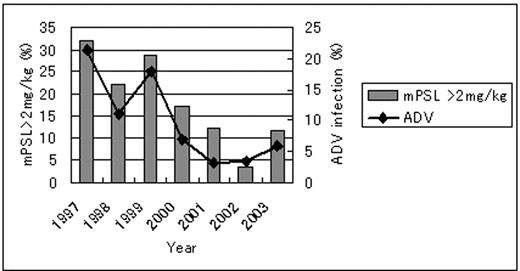Abstract
Steroid is the key drug for acute GVHD, however, steroid therapy often increases the incidence of virus infections. But the direct evidence of steroid therapy and various virus infections after transplantation has not been reported yet. Here we evaluated the relationship between the amount of steroid therapy and incidence of virus infections during the first 100 days post transplantation. Two hundred eight patients transplanted between 1997 and 2003 were retrospectively analyzed. Methylpredonisone (mPSL) (1–2mg/kg) was used for the treatment of acute GVHD. Between 1997 and 1999, we used mPSL pulse therapy (500mg–1g/day) for the secondary treatment of GVHD. Most of these patients died of progressive gut GVHD. However, autopsy revealed that cause of death was transplantation related microangiopathy. (Nishida et. al. BMT33, 1143) Thus, since 2001, mPSL pulse therapy has not been used for steroid resistant GVHD. In addition, for the initial treatment of GVHD, we prefer to use 1mg/kg of mPSL for the same reason. Thus, in our institute, amount of steroid was decreased after 2001. Patients were divided into 2 groups according to the initial dose of methylpredonisone (mPSL) used before day 100; Group A (0.5–1.0 mg/kg), Group B (≥2 mg/kg). Interestingly, the incidence of adenovirus infection was well correlated with the percentage of patients in Group B. (Table and Figure) In 1997, 1998 and 1999, percentage of patients in Group B (≥2mg/kg of mPSL) was 32.1, 22.2 and 18.6%, respectively, and incidence of adenovirus infection was 21.4, 14.8 and 17.9%, respectively. Whereas in 2001, 2002 and 2003, percentage of patients in Group B was 12.5%, 3.4% and 11.8%, respectively and incidence of adenovirus infection was 3.1, 3.4 and 5.9%, respectively. On the contrary, incidence of CMV, HSV and HZV infections was not correlated with the steroid therapy, suggesting that each virus has its own threshold of immunosuppression for reactivation. Reactivation of CMV (antigenemia) generally occurred after transplantation independent on the amount of steroid used. However, reactivation of adenovirus may require additional immunosuppression such as middle to high dose of mPSL. In our previous study, steroid therapy was a risk factor of adenovirus infection. (Miyamura et. al. BMT4, 535, BMT25, 545) There is no relationship was observed steroid therapy and HSV and HZV infections. They are commonly observed in a host whose immunological status is normal, suggesting that immuno-suppression is not crucial for these herpes virus infection. Three patients who received ATG developed EBV infection in this population. Reactivation of EBV may need greater immunosuppression than reactivation of adenovirus needs. These differences may reflect the precursor frequencies of CTL against each virus.
percentage of patients who received >2mg mPSL and Incidence of virus infection
| . | 1997 . | 1998 . | 1999 . | 2000 . | 2001 . | 2002 . | 2003 . |
|---|---|---|---|---|---|---|---|
| mPSL ≥2mg/kg | 32.1 | 22.2 | 18.6 | 17.2 | 12.5 | 3.4 | 11.8 |
| ADV | 21.4 | 14.8 | 17.9 | 6.9 | 3.1 | 3.4 | 5.9 |
| CMV | 42.9 | 55.6 | 60.7 | 34.5 | 56.3 | 51.7 | 55.9 |
| VZV | 3.6 | 14.8 | 7.1 | 17.2 | 9.4 | 17.2 | 5.9 |
| HSV | 25.0 | 3.7 | 7.1 | 0.0 | 3.1 | 3.4 | 5.9 |
| . | 1997 . | 1998 . | 1999 . | 2000 . | 2001 . | 2002 . | 2003 . |
|---|---|---|---|---|---|---|---|
| mPSL ≥2mg/kg | 32.1 | 22.2 | 18.6 | 17.2 | 12.5 | 3.4 | 11.8 |
| ADV | 21.4 | 14.8 | 17.9 | 6.9 | 3.1 | 3.4 | 5.9 |
| CMV | 42.9 | 55.6 | 60.7 | 34.5 | 56.3 | 51.7 | 55.9 |
| VZV | 3.6 | 14.8 | 7.1 | 17.2 | 9.4 | 17.2 | 5.9 |
| HSV | 25.0 | 3.7 | 7.1 | 0.0 | 3.1 | 3.4 | 5.9 |
Figure
Disclosure: No relevant conflicts of interest to declare.
Author notes
Corresponding author


This feature is available to Subscribers Only
Sign In or Create an Account Close Modal